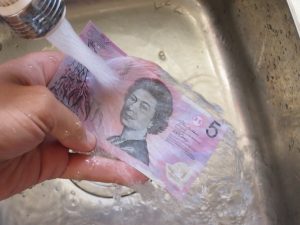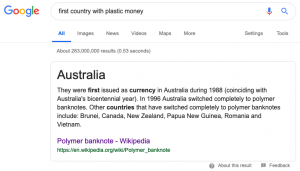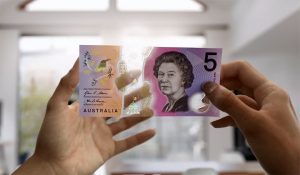In 1966, Australia switched from pounds to decimal currency. The country’s central bank issued a new range of banknotes with modern safety features – including watermarks, woven metal thread and raised print. But these technologies couldn’t prevent a $900,000 swindle.

Polymer banknotes are banknotes made from a polymer such as biaxially oriented polypropylene (BOPP). Such notes incorporate many security features not available in paper banknotes, including the use of metameric inks. Polymer banknotes last significantly longer than paper notes, causing a decrease in environmental impact and a reduced cost of production and replacement.
Modern polymer banknotes were first developed by the Reserve Bank of Australia (RBA), Commonwealth Scientific and Industrial Research Organisation (CSIRO) and The University of Melbourne. They were first issued as currency in Australia during 1988 (coinciding with Australia’s bicentennial year). In 1996 Australia switched completely to polymer banknotes. Other countries that have switched completely to polymer banknotes include: Brunei, Canada, New Zealand, Papua New Guinea, Romania and Vietnam. The latest countries to introduce polymer banknotes into general circulation include: the United Kingdom, Nigeria, Cape Verde, Chile, The Gambia, Nicaragua, Trinidad and Tobago, Mexico, Maldives, Mauritania, Botswana, São Tomé and Príncipe, North Macedonia, the Russian Federation, Armenia, Solomon Islands, Egypt, the Organisation of Eastern Caribbean States (OECS).
History

In 1967 forgeries of the Australian $10 note were found in circulation and the Reserve Bank of Australia was concerned about an increase in counterfeiting with the release of colour photocopiers that year. In 1968 the FGH started collaborations with RTASOC, and funds were made available in 1969 for the experimental production of distinctive papers. The insertion into banknotes of an optically variable device (OVD) created from diffraction gratings in plastic as a security device was proposed in 1972. The first patent arising from the development of polymer banknotes was filed in 1973. In 1974 the technique of lamination was used to combine materials; the all-plastic laminate eventually chosen was a clear, BOPP laminate, in which OVDs could be inserted without needing to punch holes.
They were first issued as currency in Australia during 1988 (coinciding with Australia’s bicentennial year). In 1996 Australia switched completely to polymer banknotes. Other countries that have switched completely to polymer banknotes include: Brunei, Canada, New Zealand, Papua New Guinea, Romania and Vietnam.
Security features

Polymer banknotes usually have three levels of security devices. Primary security devices are easily recognisable by consumers and may include intaglio, metal strips, and the clear areas of the banknote. Secondary security devices are detectable by a machine. Tertiary security devices may only be detectable by the issuing authority when a banknote is returned.



